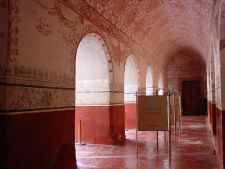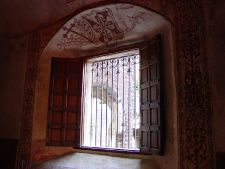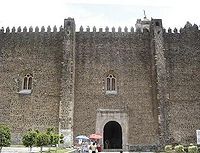Difference between revisions of "Monasteries on the slopes of Popocatépetl" - New World Encyclopedia
Mary Anglin (talk | contribs) |
Mary Anglin (talk | contribs) |
||
| Line 63: | Line 63: | ||
[[Tochimilco]] is located on one of the slopes of Popocatépetl within the state of [[Puebla]]. A sixteenth century Franciscan [[convent]] was built there. The church shows a [[Renaissance]] [[facade]]. The [[portico]] lies to the right of the facade and leads to the [[cloister]] with arcades. | [[Tochimilco]] is located on one of the slopes of Popocatépetl within the state of [[Puebla]]. A sixteenth century Franciscan [[convent]] was built there. The church shows a [[Renaissance]] [[facade]]. The [[portico]] lies to the right of the facade and leads to the [[cloister]] with arcades. | ||
| + | |||
| + | ==References== | ||
| + | * ''Mexican Tourism Board''. [http://www.visitmexico.com/wb/Visitmexico/Visi_monasteriespopocatepet/_lang/en?show=experiences Earliest 16th-Century Monasteries On The Slopes Of Popocatépetl] Retrieved May 11, 2008. | ||
| + | * ''World Heritage Site.org''. [http://www.worldheritagesite.org/sites/popocatepetl.html Popocatepetl monasteries] Retrieved May 11, 2008. | ||
| + | * ''Heindorffhus''. [http://worldheritage.heindorffhus.dk/frame-MexicoPopocatepetl.htm Earliest 16th-Century Monasteries on the Slopes of Popocatepetl] Retrieved May 11, 2008. | ||
| + | * López Aldana, Carlos. 1950. ''Mexico's famous archaeological relics: a map of the principal archaeological ruins of Mexico : the Popocatepetl and Iztaccihuatl volcanos legend''. Mexico City: The Author. OCL 2520820 | ||
| + | * Mexico cultural and natural heritage of mankind. 1998. Mexico: CONACULTA-INAH. OCLC 51636224 | ||
| + | |||
| + | |||
== External links == | == External links == | ||
Revision as of 21:23, 11 May 2008
| Earliest 16th century monasteries on the slopes of Popocatépetl* | |
|---|---|
| UNESCO World Heritage Site | |

| |
| State Party | |
| Type | Cultural |
| Criteria | ii, iv |
| Reference | 702 |
| Region** | Latin America and the Caribbean |
| Inscription history | |
| Inscription | 1994 (18th Session) |
| * Name as inscribed on World Heritage List. ** Region as classified by UNESCO. | |
There are several monasteries near the Popocatépetl volcano in central Mexico which were built in the 16th century by members of the Franciscan, Dominican and Augustinian orders. They were a major factor in the Christianization of a very large population over a vast territory and in a short period of time. They are located in the municipalities of Atlatlauhcan, Cuernavaca, Hueyapan, Tetela del Volcán, Yautepec, Ocuituco, Tepoztlán, Tlayacapan, Totolapan, Yecapixtla and Zacualpan de Amilpas in the state of Morelos; and in the municipalities of Calpan, Huexotzingo and Tochimilco in the state of Puebla; all of these are within sight of Popocatépetl.
In 1994 these monasteries were placed on the UNESCO list of World Heritage Sites, as the fourteenth Mexican site to receive such recognition. (There are currently 26 World Heritage Sites in Mexico and 2 more under consideration for inclusion in the list.)
These monasteries are impressive in their structural austerity, with the main buildings box shaped and of imposing height, often overlooking the local habitations. Additionally, the buildings are surrounded with turreted strongwalls, giving an even more imposing air.
Dominican convent of Tepoztlán
Tepoztlán is a picturesque town located in the state of Morelos. It was occupied by the Spanish in 1521. Later on, the Dominicans came and founded a convent used for Christianizing the Indians.
The old Dominican convent has been made into a museum. This convent was constructed between 1559 and 1580, was dedicated to the Nativity of the Virgin Mary and looks like a fortress. The church was finished in 1588. This building still conserves its original frescoes on the walls that show designs related to Catholicism.
The facade of the church was built in plateresque style and has, on both sides, buttresses that support the towers (reconstructed after an earthquake that caused damage to them in 1839). There are different religious symbols above the door: sculptures that represent the Virgin Mary with the Baby Jesus between two saints (Saint Dominic and Saint Catherine of Siena) and two angels holding a screen where there was surely a carved inscription.
The one nave church ends in an apse preceded by a vault showing ogival ribs. The church leads to the cloister made up by two floors. The rooms that used the community (on the second floor) and the cells (on the first floor) are situated around the cloister. A carved cross that dates from the sixteenth century can be found to the right of the church.
Cuernavaca is the capital of the state of Morelos. Its cathedral belongs to this World Heritage Site. Its construction began in 1533 to serve as a shrine to the adjacent Franciscan convent. There is an open chapel with vaults with gothic ribs built between 1536 and 1538 next to the cathedral. It is still possible to see pieces of mural paintings from the sixteenth century in the cloister of the convent. The chapel of the Third Order whose facade was built in baroque style and which has a beautiful altarpiece made of carved wood is located in the atrium.
Augustinian convent of Atlatlauhcan
Atlatlauhcan is a town in the state of Morelos where an Augustinian convent was built between 1570 and 1600. The church is preceded by a large atrium with two small chapels; the facade of the temple has a bell gable above. There is an open chapel to the left, behind which a high tower was constructed. It has a portico that leads to the cloister whose vaults are decorated with hexagonal coffering that are painted with frescoes.
Augustinian and franciscan convent of Yecapixtla
Yecapixtla is a municipality in the state of Morelos. The Franciscans came in 1525 and built a modest chapel which was later replaced with the imposing convent-fortress whose construction was led by the Augustinian Jorge de Ávila. The church is preceded by an atrium in which there are chapels.
The facade of the church is sober and beautiful; the decoration includes cherubim and floral motifs. It has a gothic rose window above the plateresque facade which is surrounded by well carved mouldings. Below the small pediment that crowns the facade there is a symbol that resembles the five wounds Saint Francis of Assisi received and that represent those Christ suffered during the Crucifixion; another symbol that shows arrows through a heart lies to the left which represents the Augustinian Order. The church has a stone carved pulpit that dates from the sixteenth century and a gothic cupola with ribs. The cloister has vigorous columns that support the arches.
Franciscan convent of Huejotzingo
Huejotzingo belongs to the state of Puebla and is 2 100 meters above sea level, where one of the most beautiful Franciscan convents is located. This convent dates back to the sixteenth century. The colonial city started to grow from 1529, around the Franciscan convent whose construction probably began in the same year and was completed around 1570.
The convent has an atrium in whose centre there is a carved cross from the sixteenth century. Small oratories whose facades have a carved coat of arms and sculptures can be found on the corners of the atrium.
The church of the convent looks like a fortress, due to its height, and has a sober facade. It has only one nave with a beautiful vault with gothic ribs, specially below the quire and on the apse, in the background there is a large wonderful altarpiece (1586) built in plateresque style and decorated with sculptures and paintings made by the flemish artist Simon Pereyns who came to Mexico (where he died) to serve the third viceroy of New Spain, Gaston de Peralta. Fragments of mural paintings can be seen on one of the walls (in gray tones that imitate the relief of sculptures), the wall where the door of the sacristy lies is decorated with mudejar symbols. The pulpit and the seventeenth century organ are also remarkable.
The entrance to the convent has a facade with two arches, this leads to the hall, to the chapel of the Trinity and to the cloister, characterized by its two superimposed galleries, the lower one has pieces of old mural paintings, among them, an image of the Immaculate Conception. The refectory, kitchen, sacristy, and rooms are located around the cloister. Some rooms still have their original decoration on the walls.
Franciscan convent of Calpan
The Franciscan convent of Calpan was founded in 1548. A triple arcade leads to the atrium. The sober facade of the church is decorated with sculptures, some of them represent maguey flowers. The atrium has four chapels that served as small oratories. They have floral and geometric designs on their walls and bas-reliefs resembling the Annunciation, the Last Judgement, monograms, etc. A seventeenth century fountain were reconstructed in the atrium after recovering its fragments that were scattered all over the town. Calpan is in the state of Puebla.
Franciscan convent of Tochimilco
Tochimilco is located on one of the slopes of Popocatépetl within the state of Puebla. A sixteenth century Franciscan convent was built there. The church shows a Renaissance facade. The portico lies to the right of the facade and leads to the cloister with arcades.
ReferencesISBN links support NWE through referral fees
- Mexican Tourism Board. Earliest 16th-Century Monasteries On The Slopes Of Popocatépetl Retrieved May 11, 2008.
- World Heritage Site.org. Popocatepetl monasteries Retrieved May 11, 2008.
- Heindorffhus. Earliest 16th-Century Monasteries on the Slopes of Popocatepetl Retrieved May 11, 2008.
- López Aldana, Carlos. 1950. Mexico's famous archaeological relics: a map of the principal archaeological ruins of Mexico : the Popocatepetl and Iztaccihuatl volcanos legend. Mexico City: The Author. OCL 2520820
- Mexico cultural and natural heritage of mankind. 1998. Mexico: CONACULTA-INAH. OCLC 51636224
External links
All Links Retrieved May 11, 2008.
- Advisory Body Evaluation World Heritage List of Mexican Monasteries of Mexico.
- Decision: Report of the 18th Session of the Committee UNESCO Report.
- San Miguel de Allende. Candidate to be declared World Heritage San Miguel de Allende.
Credits
New World Encyclopedia writers and editors rewrote and completed the Wikipedia article in accordance with New World Encyclopedia standards. This article abides by terms of the Creative Commons CC-by-sa 3.0 License (CC-by-sa), which may be used and disseminated with proper attribution. Credit is due under the terms of this license that can reference both the New World Encyclopedia contributors and the selfless volunteer contributors of the Wikimedia Foundation. To cite this article click here for a list of acceptable citing formats.The history of earlier contributions by wikipedians is accessible to researchers here:
The history of this article since it was imported to New World Encyclopedia:
Note: Some restrictions may apply to use of individual images which are separately licensed.








